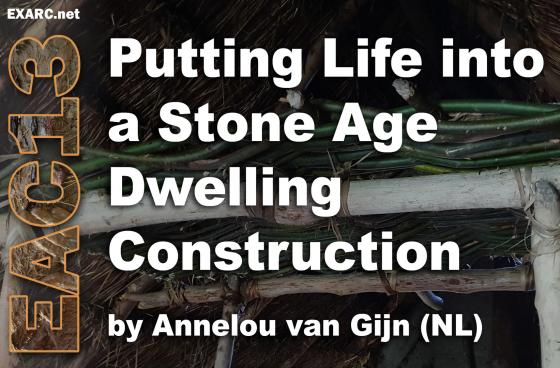
During the 13th Experimental Archaeology Conference #EAC13, two members from the project: Putting Life into Late Neolithic Houses presented their finds. In the years 2021-2025, Leiden University is coordinating “Putting Life in Neolithic Houses”. EXARC is one of the partners.
The other partners are: BIAX Consult Biological Archaeology & Environmental Reconstruction, Stichting LAB (Leids Archeospecialistisch Bureau), Woud en Beek, York University, Rijksdienst voor het Cultureel Erfgoed, Masamuda, Studio Kelvin Wilson, Het Stenen Tijdperk, and TGVideo. This project is funded by the Dutch Research Council NWO.

Putting Life into a Stone Age Dwelling Construction: A Joint Experimental Venture of Volunteers and Academics (paper)
Annelou van Gijn, Faculty of Archaeology, Leiden University, the Netherlands
Watch the video
Public participation in archaeological projects is becoming ever more essential and experimental archaeology is an excellent way of reaching out and creating a scientific community in which both the general public and archaeological scientists can learn from each other. At Masamuda near Rotterdam (Netherlands) local volunteers have established an open-air archaeological educational centre focused on the Rhine/Meuse delta. In 2016 volunteers and professional archaeologists have built a Neolithic dwelling here. In collaborative interdisciplinary research project, we attempt to fill in the details of daily life around this house: which crafts were carried out, how was food processed, and how did people move about this water-rich landscape? These questions are addressed through a combination of experimental archaeology and microwear and organic residue analysis. Discussions and practical interaction with the volunteers, each with their own knowledge and experience, have raised new questions not previously posed by archaeological scientists. These, in turn, have opened up new research avenues and alternative interpretations, to be explored through further through experiments and scientific analysis. Last, the scientific knowledge and practical expertise obtained by the volunteers is transferred to the centre’s visitors, ensuring a teaching-learning continuum outlasting the current research project.

Grinding or Polishing? Replicating grinding and polishing Traces found on Neolithic flint Axes (paper)
Lasse van den Dikkenberg, Leiden University, the Netherlands
Watch the video
Sites from the Neolithic Vlaardingen Culture (3400-2500 BC) often yield large quantities of polished axe fragments, and occasionally even complete axes are found. When studying the flint from two Vlaardingen Culture sites, Den Haag Steynhof and Hekelingen III, it became apparent that the axe fragments on both sites yielded very different finishing traces. To better understand the observed differences an experimental program was set-up to replicate these grinding and polishing traces. The experiments created a suitable reference collection for the study of these traces. Using optical microscopy we could match the replicated traces to those observed on the Neolithic axe fragments. On one site it appeared that most axes were only ground while the other site mainly yielded polished axe fragments. The polished fragments were generally polished with leather and additives. Combining experimental archaeology with optical microscopy proved to be important as it allowed us to grasp differences left by different finishing procedures which macroscopically could not have been distinguished. The experiments allowed us to distinguish between grinding on a grinding stone, with and without the inclusion of sand. Furthermore, we could distinguish between flint which was polished on a soft type of stone and flint which was polished with leather and additives.
The experiments gave valuable insights into the finishing stages of these axes, but they also raised new questions. It was generally assumed that these axes were imported to these sites in a finished state. Do these differences in finishing traces indicate that the finishing takes place in these Vlaardingen Culture settlements, rather than on the production sites? Or did different communities import different types of axes?
